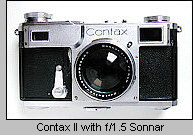In 1936, Zeiss-Ikon introduced the Contax II, which featured a redesigned body with chromed top and bottom decks and angled edges and other additions and alterations.
 A second model, the Contax III, was released a short time later and
featured an integrated but uncoupled selenium light meter.
At the time,
this was considered a major technological achievement,
having been first introduced on Zeiss-Ikon's twin-lens reflex 35mm camera, the Contaflex.
A second model, the Contax III, was released a short time later and
featured an integrated but uncoupled selenium light meter.
At the time,
this was considered a major technological achievement,
having been first introduced on Zeiss-Ikon's twin-lens reflex 35mm camera, the Contaflex.
The Contax II used a unified rangefinder/viewfinder, beating Leica to the punch by about two decades. The Contax I's tiny viewfinder was replaced by one with an image that was relatively larger and bright, although the eyepiece reticle was still fairly small.
At the same time, the film-advance knob and shutter-speed selector moved to the top of the camera, where it stayed for good. The new body now sported a self-timer and a redesigned infinity lock. Gone was the replaceable sliding viewfinder mask. Instead, the user inserted a separate viewfinder into the accessory shoe or a clip-on device that fit over the viewfinder.
By this time, Kodak's daylight-loading film cartridge was starting to gain a foothold, having arrived on the market in 1934 with its folding Retina camera. Photographers could still load their own emulsions using the Zeiss-Ikon cassette, or they could opt for the Kodak film.
Rewinding the film was a bit of a chore. The photographer had to depress and hold in a small button on the bottom of the camera while turning the rewind knob. This design feature carried through to the Contax IIa, as well as other Zeiss-Ikon 35mm cameras.
Using the Zeiss-Ikon cassettes, there was no need to rewind the film. The film simply moved from one cassette to the other. Unlocking and removing the cassette shielded the film from accidental daylight exposure.
The camera still had a wide-base rangefinder, which ensured precise focusing. Mated with either the collapsible f/2.0 Sonnar or high-speed f/1.5 Sonnar, the photographer could contend with any situation. In fact, Robert Capa carried the Contax II on June 6, 1944, when he recorded the bloody D-Day invasion of Nazi-occupied France.
The Contax II maintained backward compatibility with the growing stable of excellent Carl Zeiss Jena lenses, including the 180mm f/2.8 Olympia Sonnar -- released in time for the 1936 Olympic games held in Berlin.
The Contax continued to be a system camera, offering interchangeable backs, copying stands and external viewfinders.
In its totality, it was now a serious camera for the serious photographer and a worth competitor to the Leica.